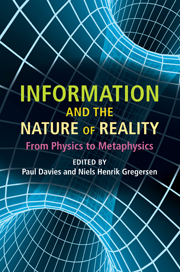4 - Universe from bit
from Part II - Physics
Published online by Cambridge University Press: 06 December 2010
Summary
“I refute it thus!” Samuel Johnson famously dismissed Bishop George Berkeley's argument for the unreality of matter by kicking a large stone (Boswell, 1823). In the light of modern physics, however, Johnson's simple reasoning evaporates. Apparently solid matter is revealed, on closer inspection, to be almost all empty space, and the particles of which matter is composed are themselves ghostly patterns of quantum energy, mere excitations of invisible quantum fields, or possibly vibrating loops of string living in a ten-dimensional space–time (Greene, 1999). The history of physics is one of successive abstractions from daily experience and common sense, into a counterintuitive realm of mathematical forms and relationships, with a link to the stark sense data of human observation that is long and often tortuous. Yet at the end of the day, science is empirical, and our finest theories must be grounded, somehow, “in reality.” But where is reality? Is it in acts of observation of the world made by human and possibly non-human observers? In records stored in computer or laboratory notebooks? In some objective world “out there”? Or in a more abstract location?
THE GROUND OF REALITY
When a physicist performs an experiment, he or she interrogates nature and receives a response that, ultimately, is in the form of discrete bits of information (think of “yes” or “no” binary answers to specific questions), the discreteness implied by the underlying quantum nature of the universe (Zeilinger, 2004).
- Type
- Chapter
- Information
- Information and the Nature of RealityFrom Physics to Metaphysics, pp. 65 - 91Publisher: Cambridge University PressPrint publication year: 2010
References
- 7
- Cited by

